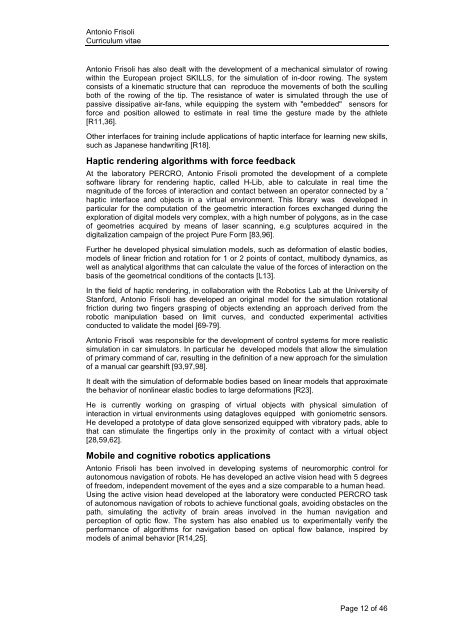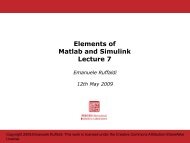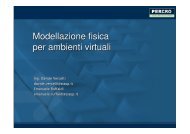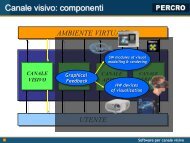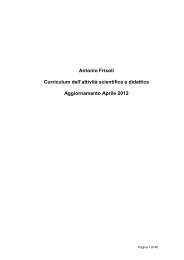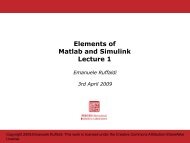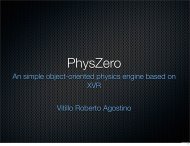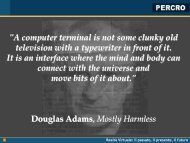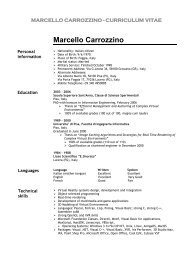English - Percro - Scuola Superiore Sant'Anna
English - Percro - Scuola Superiore Sant'Anna
English - Percro - Scuola Superiore Sant'Anna
Create successful ePaper yourself
Turn your PDF publications into a flip-book with our unique Google optimized e-Paper software.
Antonio Frisoli<br />
Curriculum vitae<br />
Antonio Frisoli has also dealt with the development of a mechanical simulator of rowing<br />
within the European project SKILLS, for the simulation of in-door rowing. The system<br />
consists of a kinematic structure that can reproduce the movements of both the sculling<br />
both of the rowing of the tip. The resistance of water is simulated through the use of<br />
passive dissipative air-fans, while equipping the system with "embedded" sensors for<br />
force and position allowed to estimate in real time the gesture made by the athlete<br />
[R11,36].<br />
Other interfaces for training include applications of haptic interface for learning new skills,<br />
such as Japanese handwriting [R18].<br />
Haptic rendering algorithms with force feedback<br />
At the laboratory PERCRO, Antonio Frisoli promoted the development of a complete<br />
software library for rendering haptic, called H-Lib, able to calculate in real time the<br />
magnitude of the forces of interaction and contact between an operator connected by a '<br />
haptic interface and objects in a virtual environment. This library was developed in<br />
particular for the computation of the geometric interaction forces exchanged during the<br />
exploration of digital models very complex, with a high number of polygons, as in the case<br />
of geometries acquired by means of laser scanning, e.g sculptures acquired in the<br />
digitalization campaign of the project Pure Form [83,96].<br />
Further he developed physical simulation models, such as deformation of elastic bodies,<br />
models of linear friction and rotation for 1 or 2 points of contact, multibody dynamics, as<br />
well as analytical algorithms that can calculate the value of the forces of interaction on the<br />
basis of the geometrical conditions of the contacts [L13].<br />
In the field of haptic rendering, in collaboration with the Robotics Lab at the University of<br />
Stanford, Antonio Frisoli has developed an original model for the simulation rotational<br />
friction during two fingers grasping of objects extending an approach derived from the<br />
robotic manipulation based on limit curves, and conducted experimental activities<br />
conducted to validate the model [69-79].<br />
Antonio Frisoli was responsible for the development of control systems for more realistic<br />
simulation in car simulators. In particular he developed models that allow the simulation<br />
of primary command of car, resulting in the definition of a new approach for the simulation<br />
of a manual car gearshift [93,97,98].<br />
It dealt with the simulation of deformable bodies based on linear models that approximate<br />
the behavior of nonlinear elastic bodies to large deformations [R23].<br />
He is currently working on grasping of virtual objects with physical simulation of<br />
interaction in virtual environments using datagloves equipped with goniometric sensors.<br />
He developed a prototype of data glove sensorized equipped with vibratory pads, able to<br />
that can stimulate the fingertips only in the proximity of contact with a virtual object<br />
[28,59,62].<br />
Mobile and cognitive robotics applications<br />
Antonio Frisoli has been involved in developing systems of neuromorphic control for<br />
autonomous navigation of robots. He has developed an active vision head with 5 degrees<br />
of freedom, independent movement of the eyes and a size comparable to a human head.<br />
Using the active vision head developed at the laboratory were conducted PERCRO task<br />
of autonomous navigation of robots to achieve functional goals, avoiding obstacles on the<br />
path, simulating the activity of brain areas involved in the human navigation and<br />
perception of optic flow. The system has also enabled us to experimentally verify the<br />
performance of algorithms for navigation based on optical flow balance, inspired by<br />
models of animal behavior [R14,25].<br />
Page 12 of 46


